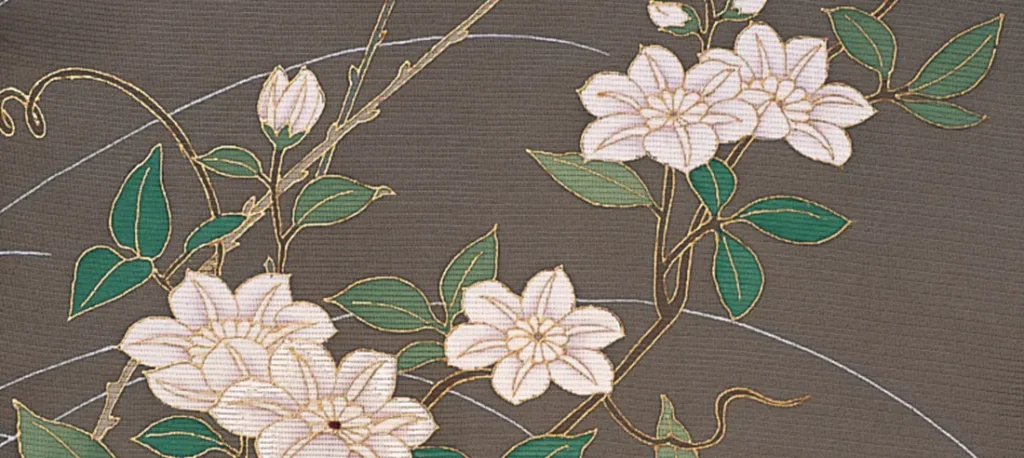The Clematis flower meaning might come from the east where it originates from.
The Clematis genus has around 1000 species but the interest in the plant is quite modern. There have been no known written references to the Clematis flower before mid 16th century.
Around the 18th century there were more varieties of Clematis introduced from China due to the increase in trade with those countries.
What does the Clematis symbolises?
The Clematis flower has various meaning some of them are: love, artfulness and soul mates. The possible powers of this plant are healing and also protection. The Clematis evergreen symbolises want and poverty.
Clematis Flower motifs in the East
The Clematis flower was recorded to be engraved on Shumidan. A Shumidan is an altar in Buddhist temples to place images.
Those Clematis were engraved in golden colour using a traditional lacquerware technique called chinkin.
The Japanese record that the Clematis were called Tessen and the name were also recorded as Tessen in historical Japanese documents. The Tessen flower came to mainland Japan from West China and from the Korean Peninsula.
The flower was also prominent in Korea where it featured on the throne of Ryukyu Kingdom. The motifs and patterns were thought to have become very popular during the Edo Era. Moreover, the patterns were also featured on various clothes such as Kosode and other different types of craftwork.
The Clematis flower meaning artfulness might have derived from the beautiful motif found in ancient Chinese, Japanese and Korean culture.
Clematis Flower Name
The word Clematis comes from the Greek word klema which translates to vine branch. However, even in ancient Greece this flower doesn’t feature a lot in any ancient poetry or myths.
It’s history begins around the 16th century. Celmatis Vitalba was also called Old man’s beard. This was due to its fluffy white seeds in autumn. The Clematis flower also had various other names such as Gypsy’s Bacca, Traveller’s Joy or Beggar’s Plant.
Introduction of Clematis flower to Britain
Around 1569 the first species of Clematis viticella was introduced to Britian from southeastern Europe. This was followed by other varities of Clematis such as Clematis Integrifolia, Clematis Cirrhosa, Clematis Flammula in 1596 and Clematis Recta in 1597.
The variety called Clematis Crispa and Clematis Viorna were introduce to Britain in 1726 and 1730 respectively from North America.
Those varieties played an important role to hybridisation. Then around 1731 the variety Clematis Orientalis was introduced from Northern Asia.
Around 1783 and 1792 even more new species were introduced namely Clematis Cirrhosa Balearice which came from the Balearic Island, and also Clematis Alpina which came from central Europe and Northeast Asia.
During the second half of the 18th century a rare species of Clematis was introduced from China. The Clematis Florida was native to a province in China called Hubei.
Barry Fretwell described this species of Clematis as a rare one. He had grown the plant sent to him from a friend who was collected the plant in Hubei. However, the plant did not become established and has since been lost in Europe.

More Clematis Species in Europe
For a long time it was believed that Carl Peter Thunberg introduced the Clematis Florida in 1776. He was rumoured to have done so from Japan into Sweden.
However, both Raymond Envison,the author of the book The Gardener’s Guide to growing Clematis and Magus Johnson, the author of Släktet Klematis claimed that the species were not Clematis Florida but bore close resemblance to another species called Clematis Sieboldii.
This variety was then produced into a double flowered cultivar which will later be called Clematis Plena. Both varieties the Clematis Sieboldii and Clematis Plena were introduced to the British Isles from the Netherlands in 1836.
In history of Clematis introduction in Britain continued even in the 19th century. Philipp Von Siebold in 1836 introduced a large flowered species from China-Clematis patens.
While Robert Fortune would introduce the variety Clematis Lanuginosa in 1850. This variety was further hybridised with Clematis Florida and Viticella.
Those species were found growing in a churchyard and it was eventually concluded that it was perhaps an earlier cultivar of the species.
The potential for more breeding came with the introduction of Japanese cultivars, Clematis Fortunei and Clematis Standishii. They were introduced by Robert Fortune too, however, the year of introduction is debatable. Christopher Lloyd states that Clematis Fortunei was perhaps introduced in either 1830s or 1840s.
If you enjoyed this blog then don’t miss on our other Winter flowers blogs.
References
Dietz, S. T. (2022). The complete language of flowers the complete language of flowers: A definitive and illustrated history – pocket edition. Wellfleet Press.
Flowers drawn in the seiden the story of the clematis. (n.d.). 首里城公園 Official Site. Retrieved December 11, 2022, from https://oki-park.jp/sp/shurijo/en/about/3798/3824
Folkard, R. (1884). Plant lore, legends, and lyrics. Embracing the myths, traditions, superstitions, and folk-lore of the plant kingdom. S. Low, Marston, Searle, and Rivington.
Watts, D., & Watts, D. C. (2007). Dictionary of Plant Lore. Academic Press.
Deena Bsingh, a UK-born, Mauritius-raised content writer, is a dedicated explorer of the ancient world’s hidden treasures. Armed with classical studies knowledge and a decade of spiritual immersion, Deena delves deep into the wellspring of ancient wisdom. Her illuminating writings on flower meanings and culinary history are imbued with the profound insights she has gathered on her journey. Through her Medium articles, she guides readers on transformative journeys that bridge the gap between ancient cultures and contemporary consciousness, offering a rich tapestry of understanding that endures through time.


